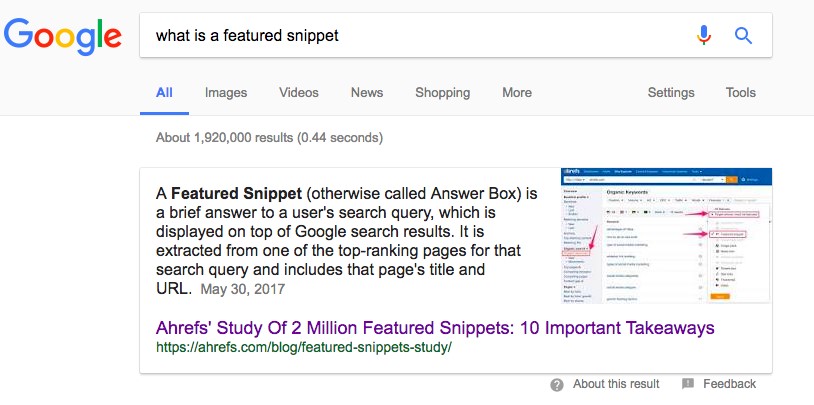Three Powerful Strategies to Hack On-Page SEO [Case Study]
As part of the WordLift team and as a blogger, I run several experiments each week to see what kind of strategies can help hack on-page SEO. These experiments provided more in-depth information regarding on-page SEO, along with the discovery of how to properly do it to help my SEO campaign.
In this article, I want to show you three factors that affect on-page SEO up to the point that if you learn to leverage them, you can hack on-page SEO.
We’ll start with a practical case study. I asked Google “what is a featured snippet,” and this is what I got:
How did they know what to show? And why is this crucial for your on-page SEO?
But, before we delve on the case study, let me clarify the main difference between on-page and off-page SEO and what they really mean:
SEO 101: Off-Page vs. On-Page SEO
When you want to make your website rank through search engines, like Google, you learn right away that there are two kinds of strategies to adopt: on-page and off-page. Often the two walk hand in hand. Yet some content marketers choose either the former or the latter.
What is the main difference?
Each time Google ranks a page, it crawls and indexes the page. Therefore, before your pages get in Google’s ranking, you may want to make sure that the previous steps of the process are taken care of, which you can do by simply publishing content or submitting your sitemap to search engines.
What we look at in this article is the final part of the process- ranking. How does a search engine decide whether a page or website deserves to rank?
It looks at authority and relevance.
Simply put, authority is about off-page SEO; while relevance is about on-page SEO.
A good proxy for authority is domain and page authority. Those are two metrics that MOZ created to assess how a domain or a page are seen through Google’s lenses.
Domain authority is connected to off-page SEO activity. In short, when other sites link to your website, from your website’s perspective those are called backlinks. The more quality backlinks you get, the more your domain authority will improve over time.
The other factor is relevance. Relevance is about on-page SEO. How is relevance assessed? There are several ways to evaluate how relevant a page can be. The main ones would be: keywords, internal linking, page formatting, user experience, and quality of data.
If I had to put it in a simple diagram, it would be:
Now that we clarified the distinction between on-page and off-page SEO let’s jump into the three steps to hack your on-page.
Step One: Target the Featured Snippet
A featured snippet is a box you see before any result on Google.
The objective is clear: give a quick answer to a user’s question.
By targeting the featured snippet, you’re going after Rank Zero. In other words, you’re not anymore targeting the first positions in Google’s SERP (Search Engine Results Page).
You may ask, why do I go for the featured snippet when I don’t even get my page to rank first? That’s the thing. Ranking first on Google isn’t enough anymore. In fact, in a few cases, Google takes content that comes from the other nine results and places it as a featured snippet.
You can see it also in this example:
On the long-tail query “what is a featured snippet”, Google is using the content coming from Ahrefs.com even though it is ranking 9th in the SERP.
Yet this is not the primary reason you want to target the featured snippet. For instance, when I compared Ahrefs and Search Engine Watch’s domain and page authority with Open Site Explorer I was stunned with the results:
Although the authority of both pages are 68; when it comes to domain authority, Ahrefs loses against Search Engine Watch.
So, why did Ahrefs gain the featured snippet? And how can you get a featured snippet when your domain authority is lower, and you’re not even ranking as number one?
First, regarding this long-tail keyword, Ahrefs won because it targeted Google’s featured snippet. In fact, when you focus on the featured snippet you shift your mindset. Therefore, your overall on-page SEO strategy changes accordingly.
How? You start doing the following things:
- Optimize for long-tail keywords
- Look for user intent to come up with a list of questions
- Structure your content to give accurate answers
In short, by changing your mindset, you automatically apply a whole new set of tactics that will make your content less conversational and more transactional. Also, your overall strategy will change. You’ll stop thinking about keywords and start focusing on user intent. That will bring your on-page SEO to a new whole level.
That also leads us to another aspect of hacking your on-page SEO strategy.
Step Two: Use Headings Strategically
The first thing you should do when writing an article (if you want to optimize for the featured snippet) is to list the questions a user might have. How? You got to be creative on that. For instance, you could use Google related searches.
Yet, if you sell a product or service, you could dig into the customer support questions and come up with a list of FAQ.
Once you have your list of questions, keep this in mind: your average reader is like a crawler.
What do I mean? Most readers won’t read the whole article. They will skim it. Therefore, headings will be a way for them to know where to focus their attention. The same applies to Google’s crawlers. When they crawl a page, headings are signals that “tell” crawlers where to focus their effort on trying to index the page.
In other words, headings are some of the most fundamental yet powerful ways to signal to crawlers that a piece of content is relevant.
That is also how the article managed to rank for that featured snippet. The most effective heading to use for the snippet is H2:
The more H2 tags you use within the article to answer specific questions the more you’re signaling toward search engines where to focus their effort. Therefore, your content’s chances to be a featured snippet increases.
That leads us to the third step.
Step Three: Structured Data
I used a Google Chrome extension called open link structured data sniffer to see what kind of data both Ahrefs had on-page compared to Search Engine Watch.
This is Ahrefs:
Compared to Search Engine Watch:
Both those websites use structured data. Yet Ahrefs uses JSON-LD while Search Engine Watch uses Microdata.
However, before we go further in-depth, let Google explain what structured data is:
Google Search works hard to understand the content of a page. You can help us by providing explicit clues about the meaning of a page to Google by including structured data on the page. Structured data is a standardized format for providing information about a page and classifying the page content; for example, on a recipe page, what are the ingredients, the cooking time and temperature, the calories, and so on.
Google uses structured data that it finds on the web to understand the content of the page, as well as to gather information about the web and the world in general.
Source: Google Developers
Therefore, structured data helps Google understand what a page or website is about. But the question is, what format does Google like the most?
The answer is JSON-LD. In fact, it is a lightweight format that allows the creation of linked data. In short, where you have a piece of content, the JSON-LD translates that in data, which is linked. Therefore, it contributes to building a smarter and better online landscape.
To keep things short, JSON-LD allows open data to be linked. For instance, to say “John Lennon’s spouse is Cynthia Lennon” the JSON-LD expresses it as it follows:
Source: json-ld.org
With this kind of strategy, you can have your website “talk” to search engines and thereby increasing your chances of being discovered by your target audience. Coincidentally, there are tools, like WordLift, that allows you to do that in a few clicks.
Connecting the Dots
At times on-page SEO seems more of an art than a science. At least that is how it seems at first sight. However, three things are crucial in my opinion:
- Switch your mindset from ranking to the snippet
- Optimize the headings
- Quality content has to walk hand in hand with the quality of data
In conclusion, by optimizing for the featured snippet you change your mindset. Suddenly, you look for long-tail keywords that resemble questions. By doing so, you also address the most specific problem points that your users and potential customers might have. Therefore, your content goes from generic to specific; from informational to transactional; and from author-centric to reader-centric.
In addition, by using your headings strategically you signal to both users and search engine crawlers where to focus when skimming your content.
Lastly, by combining the quality of content with the quality of data by using the JSON-LD format you make your readers happy while feeding Google’s crawlers what they’re looking for.
That is how you hack your on-page SEO.
Author Bio

Gennaro Cuofano is a Content Marketer and Business Developer at WordLift. After three years in the financial industry in San Diego, California, Gennaro created his blog FourWeekMBA.com where he shares his experiments and findings. He is part of the growth team at WordLift and brings his business insight to spread the value of WordLift and support its community of users.










